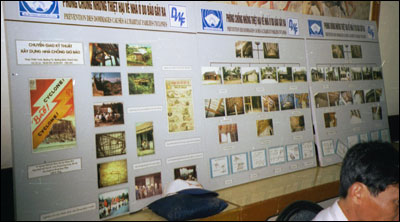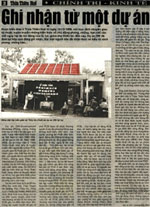| home |
Links & contacts
Press and Articles

News

Summary sheet - DIPECHO Joint Advocacy network Initiative,![]() [383KB]
[383KB]
![]() From
the grassroots - lending a helping hand for safer houses
From
the grassroots - lending a helping hand for safer houses
![]() Preventive
Strengthening of Houses against Storm
Preventive
Strengthening of Houses against Storm
![]() Safer
shelters against typhoons,
Safer
shelters against typhoons,![]() [668KB]*
Viet Nam, PDR-SEA2 News Vol 2, No 3, March-April 2004
[668KB]*
Viet Nam, PDR-SEA2 News Vol 2, No 3, March-April 2004
ARTICLE FROM THUA THIEN HUE NEWSPAPER
 Acknowledgement
from one project
Acknowledgement
from one project
By Luong Huu Duc
Implemented in Thua Thien Hue since December 15th 1999 with the aim of demonstrating and raising awareness of prevention and reduction damages caused by floods and typhoons, and reducing natural disaster, the DW project has achieved considerable results; especially, prevention awareness and understanding of from local people…
DW’s project (Prevent typhoon damage to housing, Central Vietnam) has been established since 1989-1993 as VIE.85. In 1999-2000, the project funded by CIDA & FAVC via Alternatives Association (Canada) was implemented in Thua Thien Hue, focussed mainly on raising awareness of prevention to local people, and demonstrating technique of housing resisting reinforcement. From April 2003, funded by ECHO, DW project has been continued in Thua Thien Hue with the target of encouraging and supporting families to recover the vulnerability of housing with adequate ways.
The project has been implemented in 6 partner communes (Phu Da, Vinh Hai, Thuy Thanh, Quang Tho, Thuy An, and Thuy Xuan) of the City and Districts of Thua Thien Hue. DW’s has several ways of working: animating, developing social environment to support the prevention work in practical conditions. Animation work on prevention is organized frequently in project areas with art shows, calendars, books, and banners with prevention messages, information delivery with loudspeaker of the commune, meeting, festivals, etc. Up to now, the project supports the reinforcement of 333 houses (around 4 million dong for each), and has build 21 public facilities (market, school, cultural hall, housing, safe harbour, etc.). On the other hand, the project has established prevention family groups in villages, developed community capacities, and, together with local governments, organized support actions for families and gave advices of prevention. DW actions include training courses on practical skill development in community and safe housing awareness raising, demonstrating resist reinforcement technique, reinforcing schools, raising prevention awareness to school children, developing and commercializing prevention components, organising prevention competitions such as drawing, poems, preventive building skills, and understanding of prevention: these activities have been organized many times over in the project partner communes, which attract the participation of a lot of people… The main point is encouraging and supporting families to reduce the vulnerability of housing with suitable techniques. The project has established credit program so that families can get loan with the interest rate of 0,3%. Each household can get loan of from 2 - 2,5 million dong. The key target of DW project is to help local people understand and apply 10 key principles to building. They are: Choose the location carefully to avoid the full force of the wind; Build a house with a simple shape to avoid negative pressure; Build the roof at an angle of 30° to 45° to prevent it from lifting off; Avoid wide roof overhangs, separate the veranda structure from the house; Make sure the foundations, walls, roof structure and roof covering are all firmly fixed together; Reinforce the triangular bracing in the structure; Make sure the roof covering is attached to the roof structure to prevent it from lifting; Match opposing openings; Use doors and windows that can be closed; Plant trees around the house as wind breaks. Mr. Phan Co Ngoc, a householder at Van The Dap Village, who was supported by DW with 4 million dong more or less says: “Thank the project, Party, and Government who concern the poor us. The project helps us and other families whose houses have been reinforced and all people in the commune as well have good understanding of typhoon prevention such as the 10 key principles. Our desire is how to expand the project to other communes in the province so that all people can know how to prepare and prevent typhoon effectively.”
Mr. John Norton, President of DW says in happiness: “During the period of working in Thua Thien Hue, there is an impression that I could never forget; i.e., the local people join the project with all their concern. Little children of kindergarten and primary school with their teachers’ help and the old of 70-75 years, with banners and flags, join the animation group and go around village. The prevention awareness is very high both in families and communities. Besides, another important motive contributing to the success of project is the cooperation between the Provincial People’s Committee, Project’s staff, and local governments. If in the future ECHO continues supporting and funding the project, we will choose Thua Thien Hue as our important partner for prevention investment.”
In order to develop the project in sustainability and permanence, support both in spirit and matter from relevant branches and levels should be considered more. By helping communes in remote and difficult areas eliminate temporary thatch houses and establishing web site to give information on actions of project, the project creates environment so that people can easily have better awareness of recovering housing vulnerability as well as apply key principles to building.
Thua Thien Hue Newspaper, October 2003
Annexe: Report from Newspaper
![]()
Typhoon kills 7 people in central Vietnam
Typhoon Kai-Tak, which made landfall in the central region Tuesday, has injured scores and already claimed seven lives, with local governments ready for the largest-ever mass evacuation.
The eye of the storm is near Danang city, packing winds of 103-117 km/hr, causing torrents, choppy seas, and major rivers to overflow over the last two days.
Five died and scores of others were injured in Quang Ngai province due to the inclement weather. A third-grade student and an unidentified man also drowned in neighboring Thua Thien-Hue province.
Hundreds of houses were brought down, inundated or had their roofs blown off, with hundreds of hectares of crops destroyed, dozens of fishing boats sank or went missing while roads were blocked with power supplies cut.
Thousands of trees were also uprooted in the wind gusts, blocking roads in Danang city, ravaging the sewage system.
Quang Ngai province has estimated its property damage at some VND30 billion.
Massive evacuations
In the face of the typhoon, feared to be the decade’s most powerful storm to slam into the region, affected provinces have mobilized the largest task forces possible to minimize casualties and property damage.
Over 100 coastal households in Danang have been evacuated to safer ground, with residents in two downgraded apartment buildings and temporary dwellings moved to safety.
The province also convened a meeting to discuss measures on forcing remaining households and over 200 boats docking along the Han River to safe areas.
Authorities in Quang Nam’s Hoi An town have decided to relocate over 500 families, forcing boatmen taking temporary shelter on shore. Some 283 tourists have been transferred to hotels safe and sound.
Over 748 households in Thang Binh coastal commune and along the Truong Giang River were also moved.
By 4pm Tuesday, over 15,000 households across the province have been safely relocated.
Phu Vang in Thua Thien-Hue province also moved 350 families living near Hoa Duan dam, at risk of giving way to the high tides. Local rescue workers and soldiers were mobilized for dam reinforcement.
Around 1,000 households throughout the province have been safely relocated.
Typhoon Kai-Tak, named after an old airport in Hong Kong, continues to rage, leaving huge destruction in its wake. The storm is predicted to raise river water levels even further, with more flood warnings for tomorrow.
Reported by Thanh Nien reporters Translated by Ngoc Hanh
![]() From
the grassroots - lending a helping hand for safer houses
From
the grassroots - lending a helping hand for safer houses
![]() Preventive
Strengthening of Houses against Storm
Preventive
Strengthening of Houses against Storm
